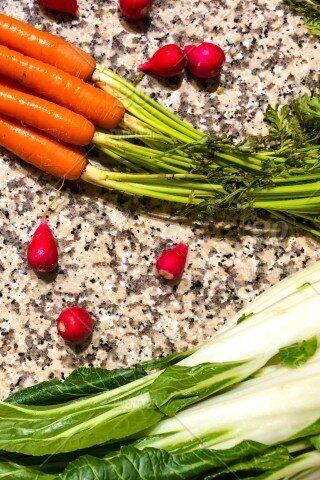Not counting, but it’s been many days of staying in and as much as I enjoy my home life and the freedom to create daily rhythms with my two kids as I see fit—I might be feeling a little stir crazy. I am confident this is the worst of it since the cold weather is on its way out and today’s sunshine, alone, has done wonders for my spirit. Anyway, this is the backdrop to my approach to this week’s recipe. I feel disconnected from the outside world and, as such, I’m not sure what type of recipe to share with all of you, given you may be going through any assortment of situations and feelings amidst this moment in history. So, I’ve decided to share my brainstorm and a summary of my findings rather than a single recipe. Here goes:
COMFORT Sweet Tooth and Chocolate-Fixes-Everything KALE
If you’re also feeling in a pit when it comes time to approach your kale of the week, maybe it’s time to make Kale Brownies. Based on my research, I think you can pretty much add 1 to 3 cups kale to your favorite brownie recipe. Raw and finely chopped is the way I’d go, but a more refined approach could also be to steam the kale until bright green and just wilted, then blend it up before adding it to your brownie batter. If you’ve got any floppy carrots that you didn’t get around to eating last week, you can steam one or two and mash it in, as well.
GREEN JUICE Keeps the Blues Away KALE
If you’re feeling good and want to eat light and clean (no added sugar, please), then maybe juice is the way to go. Slow juicers are fancy and nice, but you can also just use a blender and add kale, lettuce, any other veggies you want to consume—last week’s chard, and/or a stick or two of celery which gives it a yummy saltiness, a dash of lemon or orange juice. After a glass of green juice, I always feel more grounded and ready to make the best of my day.
BED OF KALE—A Foundation for Balance
If you’re wanting to keep a balance in your life through healthy, hearty and complete foods, you might feel good starting with a bed of kale as the foundation for your meal. What to put on your kale bed? Root veggies (try roasting the radish along with sweet potato with olive oil, salt & pepper), your protein (roasted garbanzos! eggs…or glazed walnuts or any other nut or seed, think pecans or pepitas), pasta or quinoa…Just chop and steam the kale, salt and season to taste, and top your bed of kale with whatever you like. Here’s a simple recipe for tilapia on a bed of kale you might want to try.
KALE SALAD—Keeping it Fresh for the Sunny Days Ahead
Some of us love salads. I must confess, this isn’t always me! But, with the promise of sunshine ahead (my kids were so excited about today’s sunshine, they took to running around the backyard naked for the better part of the afternoon) does make me feel better about eating cold food. A kale salad is quick, nutrient-dense, long-lasting and oh so flexible. My favorite version involves, at its simplest, chopped kale, orange and/or lemon juice, salt and a splash of balsamic or apple cider vinegar. Other ingredients might include nuts, seeds, avocado, carrots, apple, radish, and any kind of microgreens you’ve got around. Here’s a more specific Kale Salad recipe that runs along these lines.
I Need Food Now! KALE QUESADILLAS
This keeps happening, especially on days the kids and I get lost in the backyard working on projects. We hit a wall and need food NOW. Corn tortillas, cheese that melts and chopped kale (very finely chopped for the picky little ones, fat strips for me). Somehow, the kale helps me see this quick dish as more of a complete and healthy meal versus a hold-you-over junky snack. Sometimes, it’s cilantro, chard, or other leafy green instead of kale, but kale is my go-to favorite for this meal. Cholula hot sauce is my in-a-pinch salsa. I’ve switched to that over other hot sauce brands because it’s the only one I’ve found that doesn’t have a bunch of weird preservatives.











